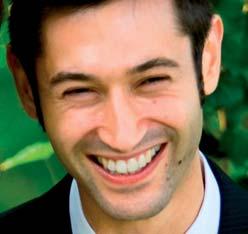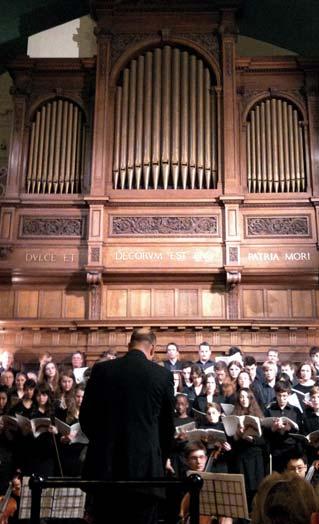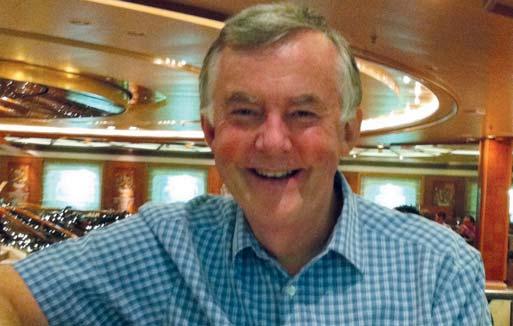
6 minute read
A History of the RGS in Ten People
from ONA 86
A HISTORY OFTHE RGS IN TEN PEOPLE
A History of the RGS continues with the search for ten people who shaped or influenced the history of the school. David Goldwater (51-62) ponders on this difficult task.
Advertisement
Any attempt at producing a ‘Top Ten’ with ease was always fraught with difficulty. We are now extending this series into the next issue of ONA Magazine and there will be an online vote in 2013. Continuing our notable Old Novo stories (which include staff as well as pupils), we begin with:
Thomas Tindle Anderson (Tucker) was born in 1894 and is probably best remembered for his gentle character during his 36 years in the Junior School (1924-60), 27 of them – formally or informally as its Head. His humanity had manifested itself in his pacifism during the First World War, something which remained a difficulty for much of his life, as he continued to serve a variety of causes dear to his heart, including the League of and later the United Nations, Spanish Food Aid (during the Civil War), Save the Children, War on Want to name a few. I recall, as a Junior School boy of the early 1950’s, Tucker having a mysterious tag – “put that light out!”, copied from older boys. It was a vestige of his days in the School’s evacuation to Penrith, a special train having left Newcastle for Penrith on September 1st 1939. Many ON’s still remember his kindly stewardship, when he served as Mr Thomas’s billeting officer. By the end of 1940, he was fully responsible for five large ‘hostels’, no mean task in wartime circumstances, far from home and his distinctive silver hair might well have dated from this time.
His involvement with the Upper School was through the many camps in England and Scotland he largely organised, something he described to Laurence Watson in 1971, when he was 77, as the most rewarding of all his concerns. He was always ready to recommend suitable clothing (“a shady hat”), buy the tickets, walk the fells, cook the food, and tell stories by the camp fire. A grocery list for 1956 speaks for itself; after five pages of camp supplies, a barely sybaritic entry: Self: Digestive biscuits, boiled sweets. Tucker retired at the age of 66 and was awarded an Honorary Master of Arts by Durham University. He died in 1972, the address at Jesmond Parish Church given by the Archdeacon of Lindsfarne.
Arthur Robert Laws (1863-1945) I am indebted to Bryan Stevens for the following notes: if we are considering the School in terms of its personalities, then surely Daddy Laws, as he was affectionately known, has as good a claim as anyone. An enthusiastic and skilful teacher of Physics and Chemistry for over 30 years, he was the first to undertake any serious research, apparently entirely on his own initiative, into the story of the School and those who have passed through it. In 1925, the year he succeeded the redoubtable ‘Bulldog’ Stallworthy as Second Master, he published a two volume history of the School down to 1845, under the title of ‘Schola Novocastriensis’, comprising not only a historical account, but also biographical notes on the masters and ONs of that period, so far as they could be traced. His grand design was to produce a third volume, on the same lines, to bring the saga up to date, a vastly ambitious and probably unrealistic project, for which he spent most of his remaining years collecting material, giving up only in 1939. When I was compiling the School Register years later, I came across all this material hidden away in a storeroom, very few people realising it was there. Until quite recently, the School was not good at looking after its records and there are now no official details of admissions prior to 1906. Laws clearly had access to the registers for the period 18701906, for he laboriously copied them out before they were lost. Without his work, the School Register (publ.1955) would have been very sketchy.
For many years, a shortened version of Laws’ history (produced jointly with J.B.Brodie, Senior English Master and author of the School Song) was presented to every new boy, sadly now discontinued.
Hugh Moises (1722-1806) succeeded the eminent classicist Richard Dawes as twenty-third headmaster in March 1749, on the recommendation of the master of Peterhouse, Edmund Keene. At that time, the School was situated at the Virgin Mary Hospital in Westgate, one of the entrance pillars of which still stands near the Stephenson memorial (Ten Objects No.2 ONA Magazine 82). He found the School ‘almost entirely deserted of scholars’ but pupil numbers grew rapidly under his stewardship and when he left there were 133 pupils. His success in reviving the School’s reputation was quickly recognized by the corporation of Newcastle, who in January 1750 raised his salary from £50 to £120. Described as affable and kind, Moises was assisted by two under-masters, by no means confining his pupils to a purely classical curriculum. English prose composition was taught, regular lectures given on the New Testament, as well as lessons on astronomy and geography, as well as Hebrew, Greek and Latin. He took great pleasure in his pupils’ successes and among his more illustrious pupils were the lawyer brothers John Scott, first earl of Eldon, and, William Scott, Baron Stowell, the Newcastle antiquary John Brand, who also taught as an usher at the school, and Admiral Cuthbert Collingwood. Of Collingwood, King George lll, when reading one of Collingwood’s despatches after Trafalgar in 1805 remarked on his splendid English, but then recalled himself that he (as well as the Scott brothers) “was one of Moises’ boys”. In 1787, Moises was succeeded as Headmaster by his son Edward and died in 1806. A fine white marble memorial by John Flaxman was placed in St.Nicholas Cathedral in 1810 by a subscription amongst his pupils. appointed Headmaster in 1948, following the retirement of Dr. E.R.Thomas after 26 years. Like his predecessor, Mr.Mitchell had presided over a successful wartime evacuation of his former school, Owen’s in Islington, (now relocated to Potter’s Bar, Hertfordshire) to Bedford Modern School. He thus came with the highest recommendations and soon proved to
Thomas Tindle Anderson
be a leader of great enthusiasm, sympathy and humour. He was a great supporter of extra curricular interests and School Societies proliferated during his Headship. If three or more boys with an interest could persuade a master to approve a Society (by becoming a Vice-President – OWM always acting as President), a new one could be created. As a keen amateur musician, OWM was proud of having no less than four orchestras at RGS.
Roger Darsley writes: “there were around 40 during my years (53-60)… O.W. Mitchell wanted children’s minds to expand rather than be confined and that’s what made the RGS so different during his time”. There was a constant stream of visitors to Eskdale Terrace. During the 1950’s, the curriculum was expanded to include Russian, Geology and Engineering Drawing, as well as General Studies in the Sixth Form. The School grew in numbers during this period from 719 in 1948 to 1,021 in 1960, Mr Mitchell presiding over ten
Oliver Worden Mitchell was extra forms, although the Governors

Oliver Worden Mitchell (picture reproduced by kind permission of Alastair Mitchell (48-55))
had yet to agree a plan to increase accommodation originally designed for 500 boys.
Mr Mitchell was an energetic networker, in modern parlance, and was ever keen to maintain close relationships with numerous organisations in the educational world and beyond. He fostered relationships with Masters and Senior Tutors at Oxford and Cambridge, though he always worked sympathetically for the individual needs of those more suited to a provincial or local university. He retired in 1960 at 62, and is still remembered with great affection by a vast number of ONs.
Still to come: Miss (Ma) Steven, legendary School Cook; Jeremy Thomas, teacher of English and Drama; Jack Wolstenholme, Head of Music; Peter Murray Taylor, Lord Chief Justice; John Elders, Sports Teacher and England Rugby Coach; John Forster, friend and biographer of Charles Dickens, John Lilburne, Thomas Addison and the Hancock brothers.








